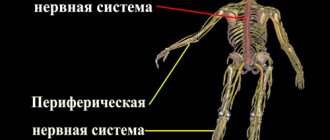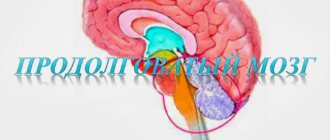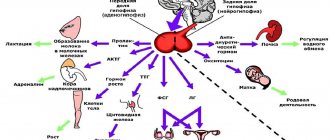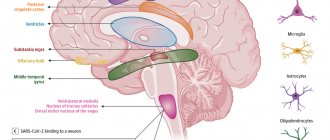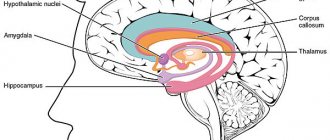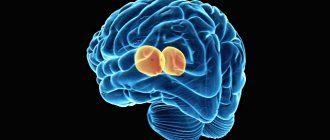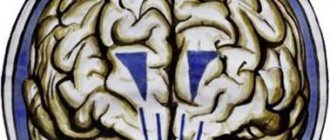The spinal cord and brain are independent structures, but in order for them to interact together, one formation is required - the pons. This element of the central nervous system acts as a collector, a connecting structure that links the brain and spinal cord together. Therefore, the formation is called a bridge , because it connects two key organs of the central and peripheral nervous system. The pons is part of the structure of the hindbrain, to which the cerebellum is also attached.
- Structure
- Functions
- Symptoms of the lesion
Structure
Varolievye formation is located on the basal surface of the brain. This is the location of the bridge in the brain.
Speaking about the internal structure, the bridge consists of accumulations of white matter, where its own nuclei (accumulations of gray matter) are located. On the posterior part of the bridge lie the nuclei of the 5th, 6th, 7th and 8th pairs of cranial nerves. An important structure lying on the territory of the bridge is the reticular formation. This complex is responsible for the energetic activation of higher-lying elements of the brain. The retinal formation is also responsible for activating the wakeful state.
Externally, the bridge resembles a cushion and is part of the brain stem. The cerebellum is adjacent to it posteriorly. Below the bridge passes into the medulla oblongata, and above into the middle brain. The structural features of the cerebral bridge are the presence of cranial nerves and many pathways in it.
On the back surface of this structure there is a diamond-shaped fossa - this is a small depression. The upper part of the bridge is limited by the medullary stripes, on which the facial hillocks lie, and even higher by the medial eminence. A little to the side of it there is a blue spot. This colored formation is involved in many emotional processes: anxiety, fear and rage.
The first Russian anatomists of the 18th century: A.P. Protasov, E.O. Mukhin, N.M. Maksimovic-Ambodik.
The first Russian anatomist is considered to be the student of M.V. Lomonosov, Academician A.P. Protasov (1724-1796), after whom, in fact, the rapid development of this science began.
Famous representatives of the Moscow anatomical school were Efrem Osipovich Mukhin (1766-1850) and Dmitry Nikolaevich Zernov (1843-1917). Mukhin organized an anatomical museum at the department and acted as a promoter of anatomical terminology. In 1812, his “Anatomy Course” was published.
. Ambodik-Maksimovich (1744-1812). Professor of midwifery (obstetrics). He made a great contribution to anatomical science, in 1783 he created an “anatomical and physiological dictionary”
Functions
Having studied the location and structure of the bridge, Costanzo Varolii wondered what function the bridge performs in the brain. In the 16th century, during his life, the equipment of individual European laboratories did not allow answering the question. However, modern research has shown that the Varoliev Bridge is responsible for the implementation of many tasks. Namely: sensory, conductive, reflex and motor functions.
The VIII pair of cranial nerves located in it This nerve also processes vestibular information, that is, it controls the location of the body in space (8).
The task of the facial nerve is to innervate the facial muscles of the human face. In addition, the axons of the VII nerve branch and innervate the salivary glands located under the jaw. Axons also extend from the tongue (7).
V nerve – trigeminal. Its tasks include the innervation of the masticatory muscles and the muscles of the palate. Sensory branches of this nerve transmit information from receptors in the skin, nasal mucosa, surrounding skin of the apple and teeth (5).
In the pons there is a center that activates the center of exhalation , which is located in the adjacent structure below - the medulla oblongata (10).
Conducting function: most of the descending and ascending pathways pass through the nerve layers of the bridge. These tracts connect the cerebellum, spinal cord, cortex and other elements of the nervous system with the pons.
Pathology
Depending on the localization of the lesion in the pathology of M. g. m., various wedges and syndromes develop. Loeb and Meyer (C. Loeb. JS Meyer, 1968) distinguish ventral, tegmental and lateral pontine syndromes, as well as various combinations thereof (eg, bilateral ventral syndrome, ventral and lateral syndromes, ventral and tegmental syndromes, bilateral tegmental syndrome).
Rice. 3. Schematic representation of cross sections of the pons of the brain at the level of its caudal (a), middle (b) and upper rostral (c) third: areas of damage to the pons that cause the development of various syndromes are shaded (I, III, V, VI - tegmental; II , IV, VII - ventral; VIII - lateral); 1 - nucleus of the abducens nerve; 2 - intrapontine fibers of the facial nerve; 3 - cavity of the fourth ventricle; 4 - medial loop; 5 - pyramidal paths; 6 - spinal tract of the trigeminal nerve; 7 - inferior cerebellar peduncle; 8 - superior cerebellar peduncle; 9 - middle cerebellar peduncle; 10 - trigeminal nerve; 11 - motor nucleus of the trigeminal nerve; 12 - lateral loop; 13 - superior sensory nucleus of the trigeminal nerve; 14 - posterior longitudinal fascicle.
Ventral pontine syndrome, which develops with unilateral damage to the middle and upper (rostral) part of the base of the bridge (Fig. 3, b-IV, c-VII), is characterized by contralateral hemiparesis or hemiplegia, with bilateral damage - quadriparesis or quadriplegia, and occasionally lower paraparesis; Quite often pseudobulbar syndrome develops (see.
Pseudobulbar palsy); in some cases, a disorder of pelvic functions is observed. Damage to the caudal part of the base of the bridge (Fig. 3, a-II) is characterized by Millard-Hübler syndrome (see Alternating syndromes). Tegmental pontine syndrome occurs when the posterior part (tire) of the bridge is affected.
A lesion in the caudal third of the tegmentum (Fig. 3, a-I) is accompanied by the development of lower Foville syndrome (Fauville-Millard-Gubler syndrome), with homolateral damage to the VI and VII cranial nerves and paralysis of gaze towards the lesion. When the caudal part of the tegmentum is affected, Gasperini syndrome is also described, which is characterized by homolateral damage to the V, VI and VII cranial nerves and contralateral hemianesthesia.
Lesions in the middle third of the tegmentum (Fig. 3, b-III) are characterized by Grene's syndrome (crossed sensory syndrome): homolateral loss of sensitivity on the face, sometimes paralysis of the masticatory muscles, contralaterally - hemihypesthesia; sometimes ataxia and intention tremor are observed in the homolateral limbs due to damage to the superior cerebellar peduncle.
A lesion in the rostral third of the tegmentum (Fig. 3, c-VI) often causes Raymond-Sestan syndrome (see Alternating syndromes), also called upper Foville syndrome. Damage to the tegmentum in this third of the bridge, in particular damage to the superior cerebellar peduncle (Fig. 3, c-v), can also lead to the development of myoclonus of the soft palate (“nystagmus” of the soft palate), and sometimes the muscles of the pharynx and larynx.
With acute damage to the bridge tire, severe impairment of consciousness may also occur. Lateral pontine syndrome (Marie-Foy syndrome), associated with damage to the middle cerebellar peduncles (Fig. 3, c - VIII), is characterized by the presence of homolateral cerebellar symptoms; sometimes, with more extensive damage, cross hemihypesthesia and hemiparesis are observed.
With total damage to the bridge, there is a combination of signs of bilateral ventral and tegmental syndromes, sometimes accompanied by the so-called. locked-in syndrome, when the patient cannot move his limbs or speak, but he retains consciousness and eye movements. This syndrome is a consequence of true paralysis of the limbs and anarthria as a result of bilateral damage to the motor and corticonuclear pathways.
From patol, processes most often in the region of M. g. m. there are heart attacks as a result of occlusive, usually atherosclerotic, damage to the vessels of the vertebrobasilar system; less frequent are hemorrhages that develop as a result of arterial hypertension. The syndromes observed in these cases are characterized by great polymorphism, but the presence of classical alternating syndromes is not very common.
The clinical picture of infarction varies depending on the level of vascular damage to the vertebrobasilar system and the possibilities of collateral circulation. Wedge, the manifestations of hemorrhages in the bridge depend on the topic of the lesion, the rate of their development and the presence or absence of blood breakthrough into the fourth ventricle. Rarely occurring arteriovenous malformations (aneurysms) in the area of the bridge are characterized by a progressive increase in neurol, symptoms associated with damage to the bridge, trigeminal neuralgia; their sudden rupture with subarachnoid and parenchymal hemorrhage is possible. Saccular aneurysms can also cause hemorrhages.
In the area of the bridge there are tumors (gliomas) and tuberculomas (see Brain). The early stages of gliomas, when the lesion is unilateral, as well as tuberculomas, usually localized in the tegmentum, are characterized by the presence of alternating pontine syndromes; later, as the patol process spreads, damage to a number of cranial nerve nuclei, as well as pyramidal and cerebellar tracts is observed (due to effective anti-tuberculosis therapy, tuberculomas have become rare). Wedge, signs of involvement of the M. g. m. may appear as the tumor of the cerebellopontine angle grows.
The defeat of M. g.m. is often observed in acute poliomyelitis, which is usually clinically manifested by “nuclear” paralysis of the facial muscles.
The most common type of traumatic injury to the pons is hemorrhage into its parenchyma, which develops along with hemorrhages in other parts of the brain.
Wedge, a picture of central pontine myelinolysis, which is based on acute death of the myelin sheaths in the central part of the myelin sheath, is characterized by rapidly progressing pyramidal disorders up to quadriplegia, pseudobulbar palsy, tremor, rigidity, mental and intellectual impairment, and death over several weeks or months. The etiology of the disease is unclear, but its connection with hron, alcoholism and eating disorders is noted.
Treatment of M.'s lesions is carried out taking into account the nature of the patol. process and its stages.
Bibliography: Antonov I.P. and Gitkina L.S. Vertebro-basilar strokes, Minsk, 1977, bibliogr.; Bekov D. B. and M and x i l about in S. S. Atlas of arteries and veins of the human brain, M., 1979; B l u m e n a u L. V. The human brain, p. 129, L.-M., 1925; Bogolepov N.K. et al. Nervous diseases, p. 44, M., 1956;
Differential diagnosis of cerebral hemorrhages and cerebral infarctions in the acute period, ed. G. 3. Levina pi G. A. Maksitsova, p. 77, L., 1971; Zh at the island and G. P. Neural structure and interneuron connections of the brain stem and spinal cord, M., 1977; K r about l M. B. and F e d o-r about in and E. A. Basic neuropathological syndromes, M., 1966;
Vascular diseases of the nervous system, ed. E. V. Schmidt, p. 308, M., 1975; T r and m-f about in A. V. Topical diagnosis of diseases of the nervous system, L., 1974; Adams R.D., Victor M.a. Manca 1 1 EL Central pontine myelinolysis, Arch. Neurol. Psychiat. (Chic.), v. 81, p. 154, 1959; B ai 1 e at O. T., B runo M. S. a. Ober W.B.
Central pontine myelinolysis, Amer. J. Med., v. 29, p. 902, 1960; Gottschick J. Die Leistungen des Nervensystems, Jena, 1955; Handbook of clinical neurology, ed. by PJ Vinken a. G. W. Bruyn, v. 2, p. 238, Amsterdam - NY, 1975; KemperT.La Romanul FC State resembling akinetic mutism in basilar artery occlusion, Neurology (Minne-ap.), v. 17, p. 74, 1967;
D. K. Lunev; V.V. Turygin (an.).
Like any organ in the human body, the VM can also stop functioning and this can be caused by the following diseases:
- stroke of the cerebral arteries;
- multiple sclerosis;
- head injuries. Can be obtained at any age, including during childbirth;
- tumors (malignant or benign) of parts of the brain.
In addition to the main reasons that can provoke brain pathologies, you need to know the symptoms of such a lesion:
- the process of swallowing and chewing is impaired;
- loss of skin sensitivity;
- nausea and vomiting;
- nystagmus is eye movements in one specific direction, as a result of such movements one can often feel dizzy, even to the point of loss of consciousness;
- may see double when turning the head sharply;
- disturbances in the functioning of the motor system, paralysis of certain parts of the body, muscles, or tremors in the hands;
- in case of disturbances in the functioning of the facial nerves, the patient may experience complete or partial anemia, lack of strength in the facial nerve;
- speech disorders;
- asthenia – decreased strength of muscle contraction, rapid muscle fatigue;
- dysmetria - incompatibility between the task of the movement being performed and muscle contraction, for example, when walking, a person may raise his legs much higher than necessary or, on the contrary, may stumble over small bumps;
- snoring, in cases where it has never been observed before.


